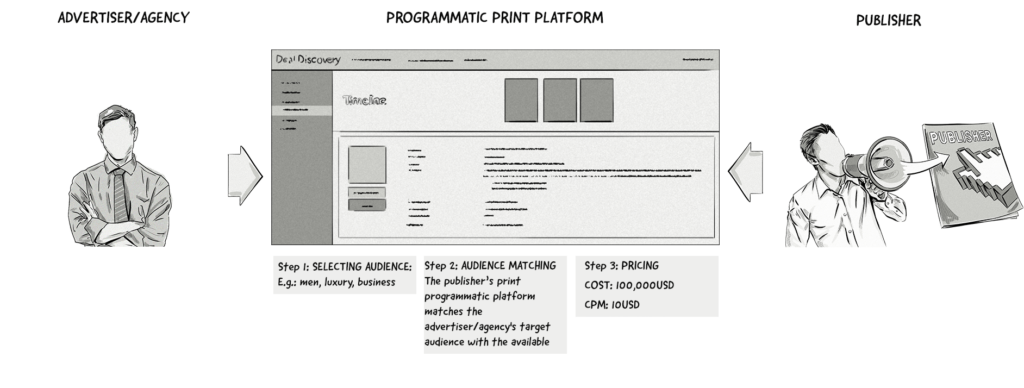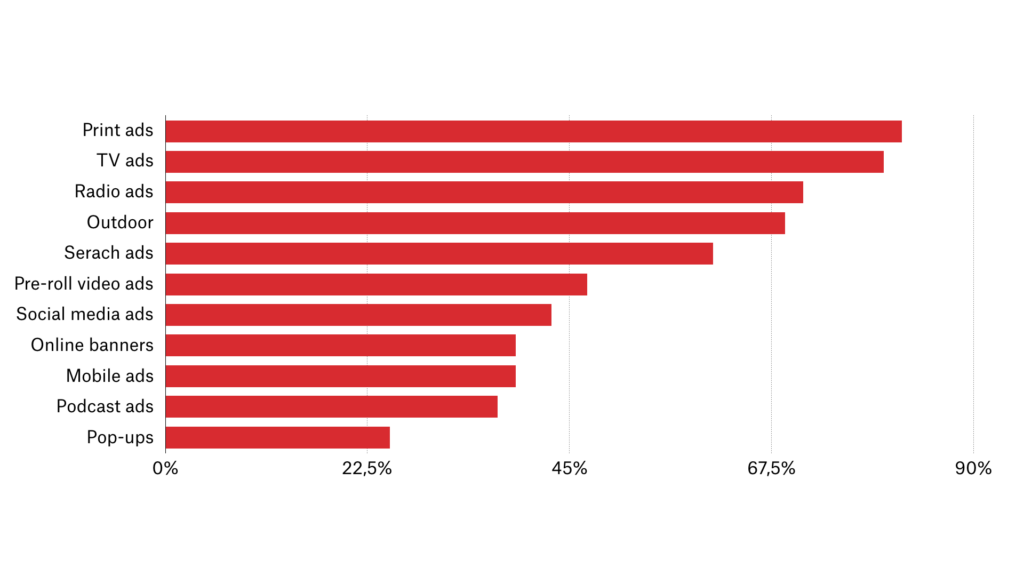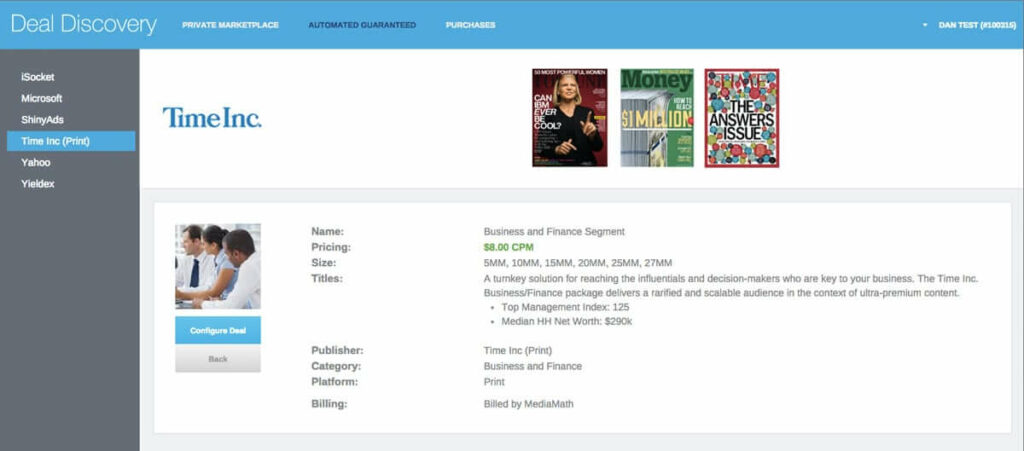With ongoing technological advancements and vast advertising opportunities, programmatic is slowly making its way to new areas of advertising – some of which not long ago seemed completely impervious to automation.
Yet, we are witnessing a steady shift from manual media-buying processes towards automated (i.e. programmatic) processes in a number of different media: out-of-home advertising becomes programmatic out-of-home advertising, audio ads become programmatic audio ads and, ultimately, print ads become print programmatic ads.
Print programmatic is a relatively novel concept, but its appeal is strong, and possibilities very tantalizing.
What Is Print Programmatic?
Print programmatic (or programmatic print) is the use of programmatic ad selling and distribution methods for traditional print ads and direct mail. The technology works much like programmatic display ads, with the exception that the whole process is much slower (i.e. not real-time like in display ads).
Also, quite understandably, targeting in print is not as granular as RTB display ads made us used to. This is because publishers can’t afford to print dozens (or hundreds) of versions of the same magazine and send it to subscribers.
How Does Print Programmatic Work?
Print programmatic is not exactly an RTB-based process (it’s neither real-time nor bidding-based). Due to certain technical constraints, it’s more similar to an invite-only variation of programmatic guaranteed at the moment.
While the process would be different for every vendor, the basic flow for the programmatic process in print looks like this:

Step 1: Selecting Audience
An advertiser/agency uses the programmatic platform to select which audience it would like to target (e.g. women aged 30-45). The publisher and advertiser/agency agree on the price (and possibly contextual placement as well, e.g. next to an article about women’s fashion)
Step 2: Audience matching
The print programmatic platform matches the advertiser/agency’s audience with the available inventory in its print publications.
Step 3: Pricing
Audiences are sold on CPM basis, which mimics the popular model known from online advertising. In print, however, it requires a two-month lead time to meet the needs of print.
For example: when publishing a full-page ad in a magazine costs $100,000 and reaches an audience of 10 million adults, it translates to $10.00 CPM.
What Are the Benefits of Print Programmatic?
While it is true that the print medium is long past its heyday in terms of demand, the appeal of print ads is still strong – after all, they are resistant to ad-blocking software and offer access to specific and highly engaged audience segments (e.g. people aged 65+) which may not be that easily accessible via traditional display ads.
The splice of programmatic and print offers multiple benefits for both publishers and advertisers. Above all, it gives print publishers a way to integrate print media into the programmatic systems which are familiar to agencies and where the bulk of advertisers already book and purchase their digital campaigns.
Automation
Print programmatic is a step towards a more streamlined, cost-efficient ad-delivery process, wherein the right message is displayed to the right person at the right time. Automation technology promises access to this “premium” inventory the same way it does for digital inventory, and takes advantage of all the benefits the print medium offers.
Extra Revenue for Publishers
On the publisher side, programmatic is an additional source of ad revenue (Time Inc. claims its advertisers have already bought over a million dollars of inventory, and estimates further growth) helping to maximize yield for low-demand inventory.
Untapped Audiences
For advertisers, print programmatic opens doors to previously untapped, non-digital audiences. It is a first step towards a truly multi-publisher and cross-platform system where advertisers can buy and publishers can sell print ads with minimal human interaction.
Consumers’ reactions across different channels are hard to predict, but many facts speak in favor of print ads. There are people who are either wary about display ads or don’t see them at all (be it for banner blindness or ad blockers).
Trustworthiness
A majority of consumers consider print ads more trustworthy; 82 percent of people say print is the most trustworthy medium for making purchasing decisions. Evidently, print ads, while they cannot remedy the decline of the medium, have undeniable appeal and shouldn’t be underestimated.

Cost Efficiency and Convenience
Print programmatic offers a way to automate specific processes of ad delivery: audience targeting, programmatic guaranteed and engagement measurement.
It eliminates, or at least reduces, the need for a human salesperson, which could be an attractive proposition for cost-conscious executives.

By using a programmatic platform, ad agencies and advertisers can quickly find relevant magazine brands, selecting from a range of available inventory, and buy ads for a multi-publisher campaign with a single click of a button. On top of that, publishers could also guarantee the editorial context of where the ad will appear in print.
What Are the Growing Pains of Print Programmatic?
Along with all the benefits, programmatic print is also associated with some problems, many of which stem from the nature of the programmatic process.
Lack of Scale
Supply of print media available programmatically is still much bigger than its demand, which leads to underselling and underpricing of media. Again, this makes auctions difficult to execute. A guaranteed (non-programmatic or programmatic direct) approach makes more sense at the moment as the industry waits for demand to match supply.
Programmatic Is Making Print Ads Less Premium
Print ads have always been considered expensive, premium inventory. Lucrative advertising deals were negotiated by advertising executives in person. The advent of programmatic print, due to its relatively small scale (for now), puts an end to this. It commoditizes the medium and erodes its premium prices.
Publishers want to offer advertisers the ease and ability to plug in data they have on their customers to better target ads, but at the same time, they don’t want to sell the inventory for nickels and dimes due to low demand. Time Inc., one of the trailblazers implementing programmatic print, sticks to guaranteed prices to make sure the value of its ads doesn’t fall below a certain level.
So, Who Is Doing It?
Time Inc. – home to brands such as People, Time, Sports Illustrated and InStyle – is currently leading the charge by offering programmatic technology to sell its media. The technology was created in collaboration with AdTech vendor MediaMath and is making Time’s print-audience segments available in the digital programmatic marketplace. It enables advertisers to buy these segments in the same way they book online display ads.
Currently, Time Inc. is offering advertisers its six audience segments programmatically: Women, Men, Lifestyle, Luxury, Business/Finance and Rapid Scale (i.e. Time Inc.’s weekly titles like Time, People and Sports Illustrated).
Direct Mailing
Print programmatic is not exclusive to magazine and newspaper ads. Publishers are experimenting with other uses of this new ad-delivery method. One of the novel ways to harness the power of automated print ad-buying is with Programmatic Direct Mail® (a term coined by PebblePost), which uses online user data and sends out retargeted messages via post.
Royal Mail also offers an automated way to help online stores maximize their conversion rates. The system sends individualized direct mail to people who visited a page, interacted with a site, or carried out a specific action (e.g. abandoned the shopping cart), helping them convert. The solution could also be used to help to up-sell or cross-sell products.
UK’s JD Williams, an online store owned by online fashion retailer N Brown Group, is experimenting with Royal Mail’s print-programmatic mail platform to tackle the problem of cart abandonment on its site.
Every piece of direct-mail creative is customized for JD Williams’ customers. The letter contains information about the item in the abandoned basket. The whole print-programmatic process requires contact data, such as address details. This, naturally, is only possible with relevant user’s consent under the GDPR. The message, along with product details and images, is prepared and printed in an automated way, and its delivery happens within 24 hours.
The figures speak for themselves – as JD Williams’ case study reveals, response rates increased by 6%, order value increased by 8%, and cart abandonment decreased by 14%.
Germany’s Deutsche Post uses similar technology. The system is called Consentric and offers the possibility to target small audiences with online behavior, based upon their profiles, with physical direct mailings. The printing and mailing process itself, like in the case of Royal Mail’s programmatic mail, is fully automated.
Final Words
The above examples demonstrate that the link between online behavior and follow-up contact through physical, direct mail is proving a successful combination.
Brands today need to be present across multiple touchpoints. Programmatic print is a way for non-digital media to take advantage of the tried-and-true ad-selling method, and by doing so possibly reach new audiences.
Because programmatic is already a big driver of digital-ad sales growth – not only for Time Inc., but for many other publishers as well – it only makes sense to try to apply it to print.







